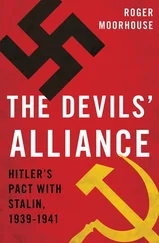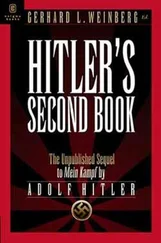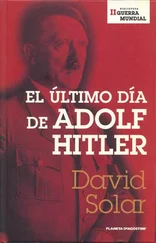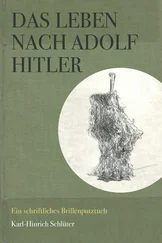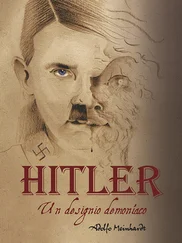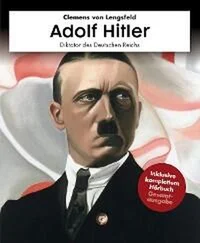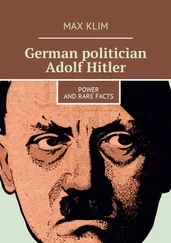Christa Schroeder - He Was My Chief - The Memoirs of Adolf Hitler's Secretary
Здесь есть возможность читать онлайн «Christa Schroeder - He Was My Chief - The Memoirs of Adolf Hitler's Secretary» весь текст электронной книги совершенно бесплатно (целиком полную версию без сокращений). В некоторых случаях можно слушать аудио, скачать через торрент в формате fb2 и присутствует краткое содержание. Город: Barnsley, Год выпуска: 2012, ISBN: 2012, Издательство: Frontline Books, Жанр: История, Биографии и Мемуары, на английском языке. Описание произведения, (предисловие) а так же отзывы посетителей доступны на портале библиотеки ЛибКат.
- Название:He Was My Chief: The Memoirs of Adolf Hitler's Secretary
- Автор:
- Издательство:Frontline Books
- Жанр:
- Год:2012
- Город:Barnsley
- ISBN:978-1-7830-3064-4
- Рейтинг книги:4 / 5. Голосов: 1
-
Избранное:Добавить в избранное
- Отзывы:
-
Ваша оценка:
- 80
- 1
- 2
- 3
- 4
- 5
He Was My Chief: The Memoirs of Adolf Hitler's Secretary: краткое содержание, описание и аннотация
Предлагаем к чтению аннотацию, описание, краткое содержание или предисловие (зависит от того, что написал сам автор книги «He Was My Chief: The Memoirs of Adolf Hitler's Secretary»). Если вы не нашли необходимую информацию о книге — напишите в комментариях, мы постараемся отыскать её.
He Was My Chief: The Memoirs of Adolf Hitler's Secretary — читать онлайн бесплатно полную книгу (весь текст) целиком
Ниже представлен текст книги, разбитый по страницам. Система сохранения места последней прочитанной страницы, позволяет с удобством читать онлайн бесплатно книгу «He Was My Chief: The Memoirs of Adolf Hitler's Secretary», без необходимости каждый раз заново искать на чём Вы остановились. Поставьте закладку, и сможете в любой момент перейти на страницу, на которой закончили чтение.
Интервал:
Закладка:
The OSAF chief of staff was retired Hauptmann Dr Otto Wagener, a former general staff officer and Freikorps street fighter, like Salomon from comfortable origins and full of vigour for putting Germany back on her feet. He had given up a directorship in industry and, relying on his comrade-in-arms Salomon, had followed Hitler’s call for collaborators. Dr Wagener lectured at Würzburg University. That he was a man of wide education with far-reaching contacts to politicians, industrialists and the nobility was obvious from the very comprehensive correspondence which I had to transcribe for him. Whilst he held the post of OSAF chief of staff, Dr Wagener drafted the ‘Economic-Political Letters’ whose length and multiplicity of subjects caused me much toil. My work for Dr Wagener was interrupted for a few weeks towards the end of 1930 when on Hitler’s orders he took over the leadership of the SA in September to fill the gap before the arrival of Hauptmann Ernst Röhm, recalled from Bolivia.
Ernst Röhm was the son of a senior railway inspector in Munich. He was commissioned in 1908 and in the First World War fought at Flaival on the Western Front. He was seriously wounded three times and lost the upper part of his nose to a shell splinter. He met Hitler in 1919 as a Reichswehr Hauptmann in Munich. As a liaison officer to the Reichswehr , Röhm was an important member of the Nazi Movement and was on familiar terms with Hitler. He was discharged from the Reichswehr for his involvement in the 1923 putsch, but a year later was active in the Deutsch-Völkische Freiheitspartei as a Reichstag Deputy and organised the National Socialist armed group Frontbann , although he gave up leadership of it once Hitler was released from Landsberg prison. At the end of 1928 he was reinstated in the rank of Oberstleutnant in the Reichswehr and as a general staff officer was sent to La Paz as a military instructor. In 1930 Hitler recalled him to lead the SA.
I then spent a couple of weeks with the Reich leadership of the Hitler Youth which at the time was housed in a private apartment. After the lively workload at OSAF I found this to be almost a punishment. When Dr Otto Wagener was appointed leader of the NSDAP Economics Office (WPA) on 1 January 1931, he asked for me as his secretary. The WPA offices with their various departments for Trade, Industry and Farming were located in the Braunes Haus at Brienner-Strasse 54, the former Barlow Palace opposite the Catholic seminary. [12] When the rented premises at Schellingstrasse 50 were no longer adequate for the NSDAP Reich leadership, on 5 July 1930 Hitler bought for RM 1.5 million the former Barlow Palace at Briennerstrasse 45. Built in 1928 it was converted by Professor Troost and Hitler, and was enlarged. Renamed ‘Braunes Haus’ on 1 January 1931, it housed the NSDAP Reich leadership on three floors. Later other buildings were purchased including two during the reconstruction of the Königsplatz on Arcisstrasse which remain standing today.
Dr Wagener used to dictate long reports about discussions he had had without mentioning the name of the other party. He also made long trips away from the office, and on his return would dictate long memoranda which when complete would then disappear into his desk. I would often get annoyed about this unnecessary production of paperwork, or so it then seemed, and all too much cloak-and-dagger. It was not until 1978 when I read the book by H.A. Turner jr, Aufzeichnungen eines Vertrauten Dr h.c. Wagener 1929–1932 [13] The title means ‘Notes by a Confidante’.
that I saw immediately that Wagener’s mysterious partner on his trips and discussions had been Adolf Hitler. His other conversation partners were Franz Pfeffer von Salomon and Gregor Strasser.
In my opinion these three saw in Hitler a singular visionary genius. They also recognised the danger of such genius which, strengthened by the suggestive power of his oratory, drew almost everybody under his spell. These three well-above-average men were probably agreed in taking the opportunity of the frequent and long conversations to test Hitler’s infallibility by queries and objections, which he would have not found pleasant. As his intuition could not be faulted with logic because it has a visionary origin and lacked any basis of logic, he considered them to be fault-finders and pedants and eventually he cast them aside.
OSAF Franz Pfeffer von Salomon was relieved of the post of OSAF and left out in the cold. [14] Franz Felix Pfeffer von Salomon (b. 19.2.1888 Düsseldorf, d.12.4.1968 Munich). Pfeffer remained in Munich without an office after his withdrawal but lived with Party associates until elected to the Reichstag on 6.11.1932. In 1933 police commissioner in Kassel; 1938 president, provincial government at Wiesbaden; 1944 briefly under arrest in connection with July Plot; interned by Allies; released 1946.
At the end of 1932 secret negotiations between Gregor Strasser [15] Gregor Strasser (b. 31.5.1892 Geisenfeld, d. 30.6.1934 Berlin). 9.6.1932 head NSDAP Reich Organisational Directorate; 8.9.1932 resigned from Party activities after accusation of disloyalty by Hitler in the Schleicher affair; expelled from the Party, returned to industry in Berlin; murdered by Gestapo by shooting at their Prinz-Albrecht-Strasse prison.
and Schleicher regarding his being offered the vice-chancellorship led to the total break with Hitler. In 1934 he was killed ‘by mistake’ during the Röhm putsch. Dr Otto Wagener moved to Berlin in 1932 and was relieved of all offices in the summer of 1933. Apparently his closest colleagues favoured him for finance minister. I never heard of him again. [16] Otto William Heinrich Wagener (b. 29.4.1888 Durlach/Baden, d. 9. 8.1971 Chieming-Stöttham/Bavaria). Took over position of acting OSAF from Salomon until 31.12.1930; from 1.1.1931 head of Economic-Political Office (WPA) at Braunes Haus; 4.9.1932 resigned office, attached to Führer-Staff for special purposes, Berlin; 20.4.1933 resumed former WPA post; 3.5.1933 Reich commissioner for trade and industry; 12.6.1933 relieved of all posts after Hitler and Göring suspected him of lobbying for post of minister for industry; following USCHLA hearing cleared of all involvement; end 1933 Reichstag deputy Koblenz-Trier; 30.6.1934 arrested in Röhm purge, released and returned to Erzgebirge to farm, but remained Reichstag deputy until 1938 and SA-Gruppenführer; fought in the Second World War; PoW (British) 1944 in rank of major general; 1947 convicted in Italy of war crimes; 1952 released.
It is no wonder that hardly anybody knows the name after he withdrew and was apparently no longer required after 1933. No doubt Dr Wagener, Pfeffer von Salomon and Strasser were personalities with too much independence for Hitler’s liking. In any case, after Hitler took power I never heard them spoken of again.
A person then active in the OSAF who did achieve a meteoric rise was Martin Bormann, still of interest today to authors and historians. The worst character traits were attributed to him, and all decisions he imposed were blamed ‘entirely on him’ postwar, not only by journalists and historians but above all by the surviving NSDAP bosses, Gauleiters, Ministers and also people of Hitler’s entourage, who should have known better.
Martin Bormann was simply one of the most devoted and loyal of Hitler’s vassals who would often force through ruthlessly and sometimes brutally the orders and directives given him by Hitler. Seen in this way, Bormann followed the same kind of path as did Franz Pfeffer von Salomon, running battles with Gauleiters, ministers, Party bosses and the rest being the rule. In the spring of 1930 at OSAF, Bormann was as yet unburdened by the far-reaching and unpleasant tasks which Hitler gave him later. Bormann could never be called an attractive man. He had married Gerda Buch, the beautiful daughter of Party judge, retired Major Walter Buch, who as the Reich USCHLA judge in the NSDAP was highly respected and enjoyed Hitler’s confidence. [17] USHLA = Untersuchungs- und Schlichtungsaussschuss , NSDAP Reich Leadership Committee of Investigation and Reconciliation, renamed ‘The Supreme Party Court’ by Hitler on 31.3.1933. Its purpose was to ‘protect the collective honour of the Party and its individual members, and where necessary to settle differences between individual members in an amicable way’.
Buch had been an active officer and subsequently an instructor at an NCO training school. In the First World War he was regimental adjutant and later commander of a machine-gun sharpshooter unit. In 1918 he took over an officer-candidate battalion at Döberitz. After the war he left the army in the rank of major and joined the NSDAP. In 1925 he was appointed USCHLA chairman, a position which required a lot of understanding for human inadequacies, much tact, energy and authority. He was predestined for the office, for his father had been president of the Senate at the Oberland tribunals in Baden. With his long face and tall, slim figure he always looked very elegant. He had been present at the marriage of his daughter to Martin Bormann, which was naturally very beneficial for Bormann’s prospects.
Интервал:
Закладка:
Похожие книги на «He Was My Chief: The Memoirs of Adolf Hitler's Secretary»
Представляем Вашему вниманию похожие книги на «He Was My Chief: The Memoirs of Adolf Hitler's Secretary» списком для выбора. Мы отобрали схожую по названию и смыслу литературу в надежде предоставить читателям больше вариантов отыскать новые, интересные, ещё непрочитанные произведения.
Обсуждение, отзывы о книге «He Was My Chief: The Memoirs of Adolf Hitler's Secretary» и просто собственные мнения читателей. Оставьте ваши комментарии, напишите, что Вы думаете о произведении, его смысле или главных героях. Укажите что конкретно понравилось, а что нет, и почему Вы так считаете.

